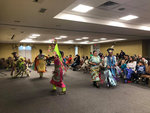
Colleton County is proud of the rich Native American culture that can be found in the area. From archeological artifacts discovered in the county, to the native people who live here, there is an appreciation of the contributions of Native Americans.
Locally, the Native American tribe that lives in and around Colleton are the Edisto Natchez-Kusso, who live near and north of Cottageville.
Tribal spokeswoman Sabrina Russell said that she feels a sense of pride in living in the area. “I feel proud that I live in the same place that my ancestors did,” said Russell. “My ancestors did what we do now, try to help people … all people. And in the past, they helped the whites survive here. Regardless of what happened in history, we were and still are trying to do the right thing. We are still here, regardless of disease, discrimination, or lack of equal education.”
Dr. John Creel is a physician in Walterboro and serves as chief of the Edisto Natchez-Kusso tribe. He runs a free clinic in Ridgeville for his people and has worked hard, along with former Chiefs Spell, Creel, Davidson, Martin and others, to become nationally and federally recognized as a tribe. At this time, they are only recognized in the state of South Carolina.
This process has been challenging and ongoing. In the 1990s and early 2000s, journalist Wes Taukchiray and Native American John Israel Muckenfuss conducted a series of interviews of people who were Indians or worked with the Indians of Creeltown, the community belonging to the Edisto Natchez-Kusso people, to document their lives.
In November of 1969, Taukchiray first traveled to Creeltown, a small American Indian settlement some nine miles north of Cottageville. There he met Elick Whitsell Creel Jr., 41, of Creeltown which is also known as Little Rock, Indian Rock, or the Pocket.
Creel said that some of his ancestors came from Mississippi in the 1700s, but most had been in S.C. on the Ashepoo and Edisto Rivers. They lived in longhouses or tents, and kept a fire inside with a pot hanging over it. He loved the history of Creeltown and knew a lot about it though he had little formal education. He remembered that a Louis Hacker taught in the Indian school for two years in 1910. But Creel learned to read in Sunday school, and his wife Flossie Creel, also an Indian of Creeltown, taught him to write.
Elick Creel went on to talk about Henry Creel who was born in 1880 and his brother Ivy who was born in 1891. They were the last two Indians at Creeltown who knew how to make white oak baskets, a craft they learned from their father. The Indians have produced none of this type of basketry since around 1939 or 1941.
The Creel brothers were also the last Indians at Creeltown to carve cypress boat paddles. Elick Creel remembers seeing Ivy Creel and Henry Creel carve them. It was becoming a lost art, but Elder John Muckenfuss remembered watching and helping the brothers carve the paddles. He made a video of how to make the beautiful oars to teach several young men and women who have recently become interested in resurrecting the skill and are working and learning to create the paddles today. The tribe has also held classes on how to carve and make draw knives.
Ivy Creel also made turkey calls out of cedar and had a hunting horn to call his dogs. The horn was made from the horn of a Texas longhorn.
B.F. Ackerman Jr., who was born in 1928, said in his interview with Taukchiray that the people of Creeltown were identified as American Indian or aboriginal back in the 1930s. Ackerman said, “We knew the folks there had Indian features and characteristics, and that they called themselves Indians. We simply called them ‘Creels.’ I believe they are descended from Indians who were friendly to white people during the Indian wars of 1715.”
As a child, Ackerman said he stole a watermelon from Native American Briz Creel’s field. Many years later, he found Briz and Alice Creel with their car broken down, stranded along the highway. “I towed them home and would not let them pay me. They never knew, but I was paying them back for that watermelon,” said Ackerman.
Ackerman was born two miles from Barts Old Field, where William Bart Creel, the common ancestor of all the Indians named Creel at Creeltown, lived according to the 1850 census. He and his wife had a total of 13 children, the foundation of Creeltown.
Creeltown had a population of 25 in the 1910 census, and 18 households in 1959. In 1969 it had 57 households and 275 people, all Indian. Some people called the community “the Indians of Four Holes” or “the reservation.”
There was an official Indian school there by 1945. Discrimination made it impossible for them to participate in public education which should have been available to all children. At that time, there were separate schools for Caucasians and for African Americans. The Indians were excluded from the white schools, and they excluded themselves from the latter because they didn’t consider themselves black. So, they were deprived of the basic education which people need in order to overcome socio-economic issues.